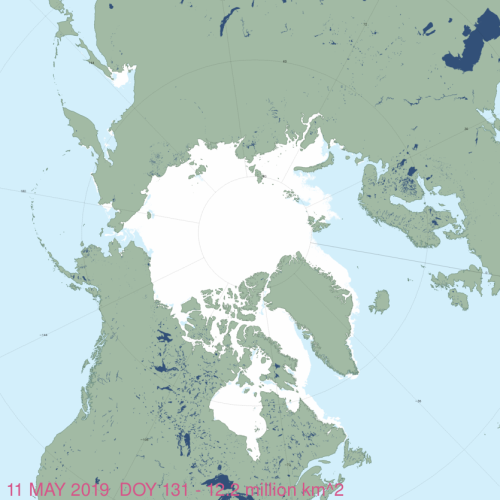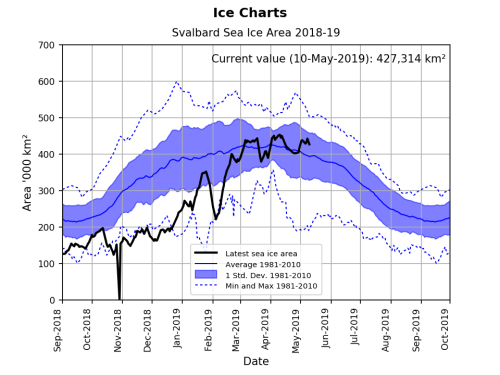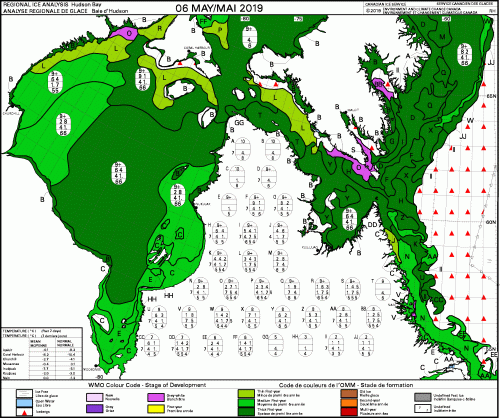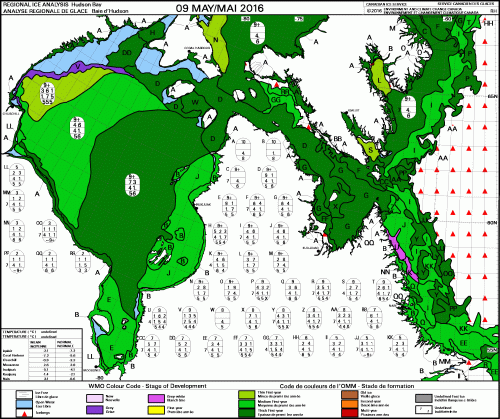The primary feeding period for polar bears is rapidly drawing to a close in much of the Arctic, although it may continue for another few weeks in the farthest north. Mating is pretty much over as well, which means the polar bears’ need for abundant sea ice is declining even more rapidly than the ice does itself at this time of year.

Despite the fact that CO2 levels have now reached 415 ppm (see tweet below), sea ice is still pretty much as it was in 2006 when CO2 was about 385 ppm. In other words, the state of sea ice at this time of year – just over 12 million kilometres squared in 2006 and in 2019 – shows no correlation with rising CO2 levels. There is also not a hint of imminent catastrophe for polar bears anywhere within their range, despite the hand-wringing messages from conservation fear-mongers and their polar bear specialist supporters.
415.26 parts per million (ppm) CO2 in air 11-May-2019 http://scripps.ucsd.edu/programs/keelingcurve/ … First daily baseline over 415ppm
The Keeling Curve
The Keeling Curve
scripps.ucsd.edu
As I’ve argued previously (with references), sea ice is a seasonal requirement for polar bears, not a year-round necessity (Crockford 2019).
GLOBAL SEA ICE

On the same date back in 2006 (11 May, below), sea ice extent was 12.4 mkm2, with much less ice than this year in the Barents Sea. Yet, by 2015, population numbers in that region had increased over the number estimated in 2004 and the bears are still thriving (Aars 2018; Aars et al. 2017):

Bering Sea to Barents Sea at 11 May 2006. NSIDC MASIE.
BARENTS SEA
Sea ice cover in the western Barents Sea (Svalbard) has been above-average for the last two months:

What does that mean for polar bears? Lots of ice north and east of Svalbard, all the way to Franz Josef Land and north of Novaya Zemlya during early spring when the bears need it most (and slightly more ice than was present in 2015, the year the last population survey was done): 
BERING/CHUKCHI SEA
While it’s true that ice coverage in the Western Arctic north of Bering Strait is lower than it has been for decades (see chart and graph below), there has been plenty of ice over the broad shallow shelf of the Chukchi Sea this year for polar bears to feed on young seals as needed. Within the next week or so all of the young seals will head for open water, leaving polar bears with nothing but predator-savvy older seals to hunt (Crockford 2019; Obbard et al. 2016). So far, Chukchi Sea polar bears have been thriving with reduced summer sea ice coverage (Regehr et al. 2018; Rode et al. 2014).

11 May 2019 Chukchi Sea, NSIDC MASIE

CANADA

Compare above to 2016:

HUDSON BAY
There is still plenty of thick first year ice (dark green, > 1.2 m thick) in Hudson Bay, Foxe Basin to the north, and in Hudson and Davis Straits to the east at the first week of May, with no open water yet showing:

In fact, there is more thick first year ice this year than there was in 2016 (below), when some rather large expanses of open water were beginning to show in the north:

Here are critical words to remember (more details here) from biologist Martin Obbard and colleagues (2016:29) on the relationship between body condition and sea ice for Southern Hudson Bay (SH) polar bears, which apply equally well to bears in other regions:
“Date of freeze-up had a stronger influence on subsequent body condition than date of break-up in our study. Though models with date of freeze-up were supported over models with other ice covariates, we acknowledge that lower variability in freeze-up dates than in ice duration or break-up dates could have influenced the model selection process. Nevertheless, we suggest that a stronger effect of date of freeze-up may be because even though break-up has advanced by up to 3-4 weeks in portions of Hudson Bay it still occurs no earlier than late June or early July so does not yet interfere with opportunities to feed on neonate ringed seal pups that are born in March-April in eastern Hudson Bay (Chambellant 2010). Therefore, losing days or weeks of hunting opportunities during June and July deprives polar bears of the opportunity to feed on adult seals, but does not deprive them of the critical spring period (Watts and Hansen 1987) when they are truly hyperphagic. No doubt, the loss of hunting opportunities to kill adult seals has a negative effect on body condition, but it appears that for bears in SH a forced extension of the fast in late fall has a greater negative effect on subsequent body condition.” [my bold]
REFERENCES
Aars, J. 2018. Population changes in polar bears: protected, but quickly losing habitat. Fram Forum Newsletter 2018. Fram Centre, Tromso. Download pdf here (32 mb).
Aars, J., Marques,T.A, Lone, K., Anderson, M., Wiig, Ø., Fløystad, I.M.B., Hagen, S.B. and Buckland, S.T. 2017. The number and distribution of polar bears in the western Barents Sea. Polar Research36:1. 1374125. doi:10.1080/17518369.2017.1374125
Crockford, S.J. 2019. The Polar Bear Catastrophe That Never Happened. Global Warming Policy Foundation, London. Available in paperback and ebook formats.
Obbard, M.E., Cattet, M.R.I., Howe, E.J., Middel, K.R., Newton, E.J., Kolenosky, G.B., Abraham, K.F. and Greenwood, C.J. 2016. Trends in body condition in polar bears (Ursus maritimus) from the Southern Hudson Bay subpopulation in relation to changes in sea ice. Arctic Science, in press. 10.1139/AS-2015-0027
Regehr, E.V., Hostetter, N.J., Wilson, R.R., Rode, K.D., St. Martin, M., Converse, S.J. 2018. Integrated population modeling provides the first empirical estimates of vital rates and abundance for polar bears in the Chukchi Sea. Scientific Reports 8 (1) DOI: 10.1038/s41598-018-34824-7 https://www.nature.com/articles/s41598-018-34824-7
Rode, K.D., Regehr, E.V., Douglas, D., Durner, G., Derocher, A.E., Thiemann, G.W., and Budge, S. 2014. Variation in the response of an Arctic top predator experiencing habitat loss: feeding and reproductive ecology of two polar bear populations. Global Change Biology 20(1):76-88. http://onlinelibrary.wiley.com/doi/10.1111/gcb.12339/abstract





